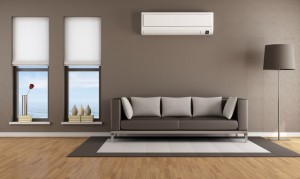Ductless, mini split air conditioning systems are growing in popularity due to their practical applications in homes, businesses and institutional buildings. Trane, Mitsubishi and Lennox have become the leaders in the mini split systems.
Each type of mini split system has advantages and disadvantages depending on your specific cooling needs. The ductless air conditioning units can be installed to cool a single room or multiple rooms at one time. The wide spread use of the mini split is contributed to the need to cool homes and structures without an existing duct system.
What is a Mini Split System?
The mini split is a ductless air conditioning system. The unit can be fitted to cool one room or multiple rooms. The singular mini split is simple in design with one condenser outdoors and an indoor unit to circulate cool air. Refrigerant lines and electrical lines are mounted through the exterior wall which allows connection to the indoor unit. Multiple indoor wall units may be installed depending on how widespread you want the cool air to circulate in a specific zone.
Single Zone versus Multi-Zone
The terminology associated with mini split systems is a single zone or multiple zones. The zones focus on the amount of rooms or calculated square feet the cooling unit will be covering. A single zone usually covers one room or a smaller area of your house. The single zone ductless air conditioning unit has one indoor component and one outdoor condenser unit. The single zone unit is usually utilized in a bedroom to provide adequate comfort.
The multi-zone system functions like a single zone unit with a larger area or rooms to keep cool at one time. The outdoor unit usually connects to four indoor units. The multi-zone unit can keep different areas within in your home cool. The multi-zone models can be utilized in homes with different levels or in an office building.
Choosing a Mini Split Ductless Air Conditioning Unit
With any type of air conditioning unit, you will have to know the required BTU to comfortable accommodate your cooling needs. Begin by calculating the amount of square feet the mini split ductless air conditioning unit will be covering. For example, an area of 350-400 square feet will need a unit that has a 9,000 BTU capacity.
A Mitsubishi mini split ductless air conditioning unit has a 12,000 BTU capacity which will generally keep an area of 450-600 square feet cool As the room or area of cooling increases in size, the BTU’s will increase to successfully accommodate. An area of 2500-2800 square feet requires a unit to be able to successful run at 60,000 BTU.
Other contributing factors will determine the amount of BTU’s needed to keep an area cool.
- The height of your ceiling in the cooling zone. Ceilings over eight feet should have an increase BTU of 20% added on to the amount figured for square feet.
- A poorly insulated house or structure will require more BTU’s to keep the area cool. If you know your house is poorly insulated, you can increase the unit BTU capacity by 30% to compensate.
- Warmer climates with temperatures reaching over 90˚F will require a BTU increase of at least 30% to compensate for the demand.
Advantages of Mini Split Ductless Air Conditioning Units
With any type of new home installation unit, weighing the pros and cons can help you make an informed decision on what to purchase.
- The mini split is a flexible small unit referred to as an “add on” system. You can have the ductless air conditioning unit installed in one room or several. In most cases, one outdoor compressor can run four indoor cooling units.
- The system does not require duct work to be installed in the house or building. With central air, you have to refit existing duct work or install new to use.
- The entire mini split system is less complicated and easy to install. The simple installation will mean lower contractor fees.
- With the condensing unit located outdoors, the overall noise of the system is reduced.
- The indoor component of the mini split is mounted to the wall or ceiling saving floor space. The condenser which saves you from making an area for your cooling unit. You do not have to worry about the unsightly large exhaust hose. The unit only needs a 2-3 inch hole to connect the outdoor condenser with the indoor cooling component.
- The mini split is a ductless air conditioning unit. When using a duct system, you are cooling a larger area which can be less energy efficient. The mini split is directed at the area you want to stay cool which allows you to remain comfortable without continuously running a larger less energy efficient system. You are lowering your operating costs which can add up to savings throughout the year.
- Mini split air conditioning units usually come with rebates and other attractive incentives.
Disadvantages of the Mini Split Ductless Air Conditioning Unit
With most new household or office installations, you must consider the disadvantages of the unit.
- The mini split system is considered a permanent “add on” system. When purchasing and placing the unit, you must realize the system cannot be easily moved around like a portable air conditioning unit.
- You will need to hire a HVAC technician to complete the installation process. The demand for the HVAC technician who is qualified to mount a mini split system may leave you waiting for installation.
- The initial cost may be higher than other portable cooling units.
- A drain has to be installed near the outdoor unit to release the condensate water.
- Poorly insulated houses or buildings will require a larger ductless air conditioning unit to compensate. The larger the unit the more power needed to run accurately which can increase monthly utility bills.
The use of mini split systems will continue to grow as customers look for ways to make a comfortable indoor atmosphere. The energy efficiency of the mini split makes the system an attractive investment. Hopefully we’ve answered some of your important questions in our ductless mini split buyers guide.






